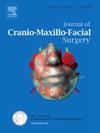Radiographic findings predictive of obstructive sleep apnea in adults: A systematic review and meta-analysis
IF 2.1
2区 医学
Q2 DENTISTRY, ORAL SURGERY & MEDICINE
引用次数: 0
Abstract
Polysomnography remains the diagnostic gold standard for obstructive sleep apnea (OSA), but it cannot be easily performed in a timely fashion within the practice of a craniomaxillofacial surgeon. Hence, in this systematic review and meta-analysis, we aimed to identify radiographic indicators that could predict obstructive sleep apnea (OSA) diagnosis. We conducted a PRISMA-compliant systematic review and meta-analysis, including 109 studies with 9817 participants (3509 controls, 6308 OSA patients), predominantly male (79% controls, 85% OSA patients). The analysis focused on CT (36, 33%), MRI (23, 21%), and lateral cephalogram findings (50, 46%). The average age and BMI for the included patients were 44.4 ± 14.4 years and 26.4 ± 5.2 kg/m2 for controls, and 51.5 ± 40.4 years and 29.8 ± 6.4 kg/m2 for the OSA group. A random-effects model meta-analysis was conducted on the measurements that met our criteria. Due to measurement differences between studies, only lateral cephalogram measurements could be included in the meta-analysis: OSA correlated with increased soft palate length and thickness, increased mandibular plane to hyoid bone distance, and decreased SNA, SNB, BaSN, SN distance, and palatal length (ANS-PNS). Although the study underscores radiographic utility for screening, PSG is necessary to establish a diagnosis of OSA.
预测成人阻塞性睡眠呼吸暂停的影像学表现:一项系统回顾和荟萃分析。
多导睡眠图仍然是诊断阻塞性睡眠呼吸暂停(OSA)的金标准,但在颅颌面外科医生的实践中,它不容易及时执行。因此,在本系统综述和荟萃分析中,我们旨在确定可以预测阻塞性睡眠呼吸暂停(OSA)诊断的影像学指标。我们进行了一项符合prisma标准的系统评价和荟萃分析,包括109项研究,9817名参与者(3509名对照,6308名OSA患者),主要是男性(79%对照,85% OSA患者)。分析集中在CT(36.33%)、MRI(23.21%)和侧位脑电图(50.46%)上。对照组的平均年龄为44.4±14.4岁,BMI为26.4±5.2 kg/m2; OSA组的平均年龄为51.5±40.4岁,BMI为29.8±6.4 kg/m2。对符合我们标准的测量结果进行随机效应模型荟萃分析。由于研究间测量值的差异,只有侧位头片测量值可以纳入meta分析:OSA与软腭长度和厚度增加,下颌平面到舌骨距离增加,SNA、SNB、BaSN、SN距离和腭长(ANS-PNS)减小相关。尽管该研究强调了x线摄影在筛查中的作用,PSG对于确定OSA的诊断是必要的。
本文章由计算机程序翻译,如有差异,请以英文原文为准。
求助全文
约1分钟内获得全文
求助全文
来源期刊
CiteScore
5.20
自引率
22.60%
发文量
117
审稿时长
70 days
期刊介绍:
The Journal of Cranio-Maxillofacial Surgery publishes articles covering all aspects of surgery of the head, face and jaw. Specific topics covered recently have included:
• Distraction osteogenesis
• Synthetic bone substitutes
• Fibroblast growth factors
• Fetal wound healing
• Skull base surgery
• Computer-assisted surgery
• Vascularized bone grafts

 求助内容:
求助内容: 应助结果提醒方式:
应助结果提醒方式:


